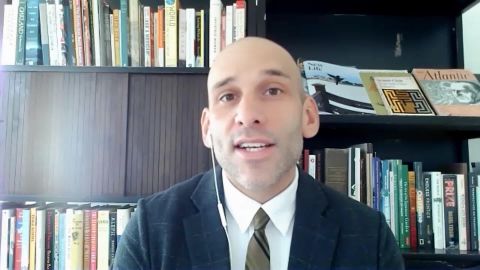Read Transcript EXPAND
CHRISTIANE AMANPOUR: And of course, COVID is dominating the United States. First the U.K., and now the U.S. say the FDA is on the brink of approving the Pfizer/BioNTech vaccine, perhaps as soon as this weekend with vaccinations beginning next week. Alexis Madrigal is staff write at the “Atlantic” who has been monitoring the pandemic since it began through this COVID Tracking Project. And here he is telling our Hari Sreenivasan how — what started as a personal interest became a vital tool in the fight against the virus.
HARI SREENIVASAN: Christian, thanks. Alexis Madrigal, thanks for joining us. For people who are unfamiliar with the COVID Tracking Project, what is it?
ALEXIS MADRIGAL, CO-FOUNDER, THE COVID TRACKING PROJECT: We’re a mostly volunteer organization that compiles state data and publishes it as a national level so people can understand what is happening with the pandemic in the United States.
SREENIVASAN: And you decided to take this task on because, why?
MADRIGAL: Well, in the early days of the pandemic, the numbers available from the federal government, particularly the numbers of tests but also hospitalizations and other things were quite incomplete. And the way they were often times presented on national websites wasn’t working for people to understand what was really happening. I mean, the really crucial thing was, people kept citing the small number of cases in the United States. But the reason we had so few cases back in the spring, particularly in February and March, is that we weren’t testing anybody. So, we started to compile the number of people who were tested by going literally with an army of people state website by state website and putting those numbers in the spread spreadsheets and coming up with useful ways of analyzing them. And there’s the whole team, data quality team, that just spends time trying to think about, find out, interact with states to say like, what — when you say hospitalization, what do you mean? When you say adept, what’s the specific definition? Because there’s huge variability across states in the way that they report key their metrics of the pandemic.
SREENIVASAN: This sounds like an opportunity or a role for a federal government to standardize what data states hand over and how often and how granular.
MADRIGAL: Yes. It is. And, you know, I think as the pandemic has gone on, what has — there’s been different problems at different times. In the early days, the data pipelines were not robust. The stuff actually just wasn’t getting into the federal government. So, CDC, the Department of Health and Human Services, they just kind of didn’t know. And it’s one of the major failures in the pandemic, in my mind. As time has gone on, they built new systems, but there wasn’t a lot of trust in those systems. And now, we’re in a new phase, where the Department of Health and Human Services has begun to release that data, which is really important. And now, we’re trying to understand what is in it, verify it, cross-check it against the kind of work we’ve been doing with the states. And I will say, the good news is, the data that has been coming out of HHS so far, in the last couple of months, is pretty solid and it gives us hope that maybe someday the COVID Tracking Project won’t actually be necessary for people to understand the pandemic because our federal government will be doing the job.
SREENIVASAN: So much of this kind of ties together all based on data. If you don’t have good information, you can’t make good decisions. If you don’t know how many cases there are in a specific area, you can’t figure out what sort of mitigation measures are required or necessary or optional.
MADRIGAL: Yes. I mean, that’s exactly right. You need data in order to make decisions. And that is true at every level of the response. It’s true at the county, it’s true at the state, it’s true at the national level. You know, in our country, the way our public health system actually rolls things out is incredibly local and incredibly distributed. On the other hand, when assistance is coming from the federal government, they need to have summary statistics about the country so they know where to send Remdesivir, so they know how to get doctors and nurses to hospitals that are being overrun. And without that crucial information, the federal response just can’t work. And when we say, as you’ve probably heard many times, that the federal response has been uncoordinated and ineffective and things like that, it’s not because there weren’t people working inside the federal government working really hard on this, there are thousands of them. It’s because, at the top, we had a ton of misinformation coming out of the administration and then deep-down in (INAUDIBLE), we had a lack of data and a lack of reliable data for actually effecting the response.
SREENIVASAN: Alexis, in the spring, when this began, there was so much talk about flattening the curve. Giving hospitals a chance so that not all of us were getting sick in surges. But in your last couple of columns that you’ve written for the “Atlantic” you’re saying that the worst-case scenarios that hospitals and doctors and epidemiologist were dreading is here now.
MADRIGAL: Yes. That’s right. I mean, it’s actually hard to talk about it. I mean, it is what we were warned about, that, you know, hospital systems in particular areas with, you know, heavy surges would just have to turn people away, have to increase the admissions standards so that people who would have gone into the hospital, you know, a few months ago with a case of COVID-19 get sent home. And what we know is that lowers the standard of care. If you just look at how many people are dying, you know, back in the early fall, our team at the COVID Tracking Project did some scenario planning. And we’re living through the worst scenario that we were able to imagine at that time having looked at this data from March to September. You know, just in the last few days, we’re seeing 3,000 deaths in an individual day and we’re, you know, edging up towards 2,500 average deaths per day in the United States. This is as bad as we thought it could get in one of the richest countries in the world, with a federal infrastructure that going into this pandemic was ranked as one of the most prepared in the entire world,
SREENIVASAN: You know, those previous spikes, in the summer and the spring, we had about 60,000 people in hospitals, and even at those times, we saw stories of nurses and doctors being overwhelmed. In December, almost every day this month, there have been more than 100,000 people in hospitals. What does that do to the system?
MADRIGAL: Yes. I mean, it kind of dials up the pressure, right? It’s not, you know, a binary, hospitals are fine when they have a little bit of capacity in the ICU, and then when they cross 100 percent, then they collapse. It’s a dial, it’s turning up the pressure on every part of that hospital system, not just on the nurses and the doctors, on the janitors, on people who serve food, all of the things that make a hospital run. The biggest difference between the previous surges and the one right now, is, in the spring, it was really quite localized in the northeast, it was quite localized around the New York metro area and a couple of others, you know, Detroit, New Orleans, but it was pretty local. What that meant was, places that weren’t seeing a lot of infections could send medical personnel to those areas to help. You remember, all of those nurses and doctors who descended on New York and fought this pandemic in the hospital. In the summer time, it was really concentrating in (INAUDIBLE), Arizona, California, Florida, Texas. And that meant that, you know, the other areas of the country could repay the favor, they could send medical personnel to those places. Now, it’s pretty much everywhere. You know, I think we have deaths rising in, you know, something like 45 of states right now. It means that medical workers need to stay put in their own regions, in their own hospitals. And so, you don’t have this flexibility of that medical workforce in other to get people moved around so that you can keep these hospitals with stacked beds and keep them from collapsing.
SREENIVASAN: And are we seeing the effects of people gathering at Thanksgiving already in the numbers?
MADRIGAL: We may, may be starting to see the very early indications of that. But really, the surges that we’re talking about over the last 10 days, that was baked in before Thanksgiving. So, given the reporting lags and given the catch-up that states and local health departments have to do, you can really start to expect to see those numbers over the next week or two weeks, and then we start to look further ahead. You know, people that got infected at Thanksgiving, infecting the next layers out, the secondary and tertiary infections. And when’s that going to line up with, it’s going to line up with Christmas travel season. So, there’s a lot that’s happening with the pandemic in the month of December that is just lining up terribly for the actual outcomes for this country.
SREENIVASAN: So, when you’ve been watching these numbers so closely, week after week, you’re starting to be able to see patterns. You’re starting to be able to see when the reported numbers are here, when it turns into hospitalizations and then, unfortunately, when it turns into deaths. And what you’re telling me now is that the ripple effects from Thanksgiving could be through Christmas and New Year’s, and, of course, there’s the Christmas holidays. So, we’re talking about possibly mid-to-late January until will we see the effect of the hospital season — or I should say the holiday season on hospitals.
MADRIGAL: That’s exactly right. Yes. I mean, I think the timeline that I keep in my head, this is very rough, is, you know, there’s a contact, you know, someone gets infected. A few days later, maybe say five, that case is confirmed. Ten days after that, maybe 12, you see the hospitalization start to rise from those infections. And, you know, about three weeks after that case is confirmed is the best match for when the death will show up in the data. So, you’re talking, there’s considerable, considerable lag in all of these metrics that we track, and it’s one of the things that makes this such a difficult problem because people can’t see the cause and effect smoothly. You know, they have to do this kind of difficult accounting for, you know, my behavior now, will mean, you know, something in a month, you know. And people are not that good at that kind of accounting.
SREENIVASAN: Whether it’s fatigue from the pandemic and the type of lifestyle changes that we’ve had to make or political indifference, whether it’s just ideological, I mean, it just seems stunning that we are now crossing 3,000 people dying a day and we’ve kind, well, normalized it.
MADRIGAL: Yes. I mean, I think it is kind of horrifying. The truth is, this is hard. You know, the federal government did not deliver enough stimulus to keep people at home. Did nothing for their restaurant industry. You know, I mean, these are huge problems that are partially caused by our politics, and we know that these things could be better. If you paid people to stay home, they would be a lot more likely to stay home. The choice was never, you know, stay home and starve or go out and work. It never had to be that way. And I think two major things happened. You know, you had a sustained misinformation campaign, largely from the right wing, that the pandemic wasn’t a big deal. And it was never an attempt to create an actual alternative working theory of, you know, federal government response, ala Sweden. Instead, it was just tossed up against all these numbers. Oh, you know, these are — that’s a case-demic. It doesn’t matter. It’s just cases. Well, actually, cases in deaths are incredibly well correlated particularly since the summer time. Oh, well, you know, these hospitalizations don’t mean anything. Some hospitals are fine. But, you know, if you look at the fine grain data coming out of individual hospital systems, some of the hospital systems are not OK. And it’s flooding the zone with bad information. And that flooding of the zone has created huge chunks of the population who just think they don’t have to worry about this. And the death numbers, the individual stories of people dying alone in a hospital at 80 years old or dying in a long-term care facility, people have been inoculated against the power and horror of those stories by bad misinformation campaigns. And honestly, it’s just so, so tragic. Particularly right now, when we know there are vaccines that are going to be approved and going to be deployed almost any minute now.
SREENIVASAN: Recently, we’ve also started to see hospital level data in certain places, but where are we at in that? Is there a steady stream now of hospitals publishing exactly what kinds of stresses they are under?
MADRIGAL: So, this is actually a small bit of fantastic news among, you know, the rest. This is a big deal. HHS, you know, Health and Human Services, is now putting out a weekly report with facility level, that means, you know, down to the hospital level data about the stress that those hospitals are under. Staffing shortages, the number of patients they have in the ICU, all these kinds of things. We just got this released this week, and it is just — it orders of magnitude better than what we’ve been able to see either, you know, just looking at the state level, which is what we’ve been able to track at the COVID Tracking Project, or just looking, you know, at just individual hospital systems that may have their own, you know, idiosyncrasies in the way that they present data. So, you’re talking about this data set is really the foundation of a dashboard you could build for seeing where hospitals were being overwhelmed. And I have no doubt that based on what the Biden campaign and transition team have said publicly, that we’re going to see something like this. And I think and I hope, having looked at some of the data preliminarily, that it will change some minds. Like when you see how many hospitals have more than 50 percent of their ICUs occupied by COVID-19 patients, that just tells you the scale of the problem. And if you look at the map, there are just red dots all over it. And I hope that when people who have become inured to the horror of this pandemic, take a look at something that, and they think about every nurse and doctor and janitor and, you know, food service worker who is in there that it changes some minds and maybe changes some behavior, because nothing that we’re doing right now is slowing down the virus.
SREENIVASAN: So, right now, are we at a point where if somebody shows up at the hospital, that the hospital, depending on how backed up they are now because of other COVID patients are going to triage them and say, maybe a month ago, we might have admitted you, but today we just can’t?
MADRIGAL: Yes, I mean, we’ve been relying on some analysis by Ashish Jha at Brown University, dean of the public health school there. And he looked at the numbers, and was able to show that a declining percentage of the cases that we’re confirming are actually becoming hospitalizations. And the most likely reason for that is that the admissions criteria have been tightened up and people are being sent back home to ride it out in their own houses where before, you know, a month or two ago, they would have been admitted into the hospital. So, the hospitalization numbers that we’re seeing, as incredibly high as they are, over 100,000 and continuing to rise, we’re like over 106,000 now, they’re even lower than they would be if we still had the admissions criteria and we’re trying to help as many people as we were back in October by hospitalizing people. So, this is just an absolute crisis for the health care system. And I think I just want to emphasize, it’s not like we’re seeing the worst. The worst is still ahead. It’s already baked in. And so, the next few weeks, I think people should prepare themselves. I mean, these numbers are not going down.
SREENIVASAN: Alexis Madrigal of the COVID Tracking Project and the “Atlantic,” thanks so much.
MADRIGAL: Thank you for having me.
About This Episode EXPAND
John Kerry discusses the Biden administration’s climate goals tonight. Activist Greta Thunberg discusses the intersectionality of the climate justice movement. Cardinal Wilton Daniel Gregory reflects on sexual abuse scandals in the Catholic church and racism in America. COVID Track Project co-founder Alexis Madrigal explains how he’s using data to fight the pandemic.
LEARN MORE



